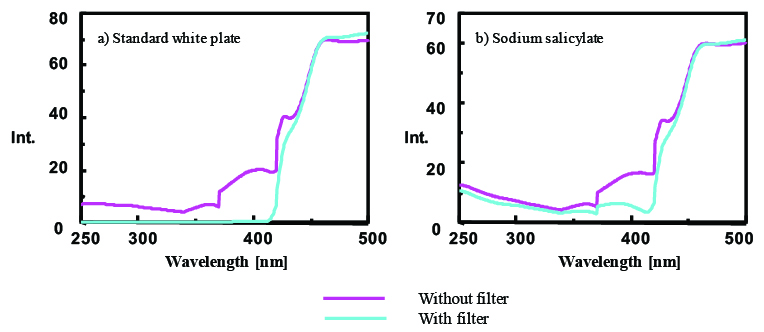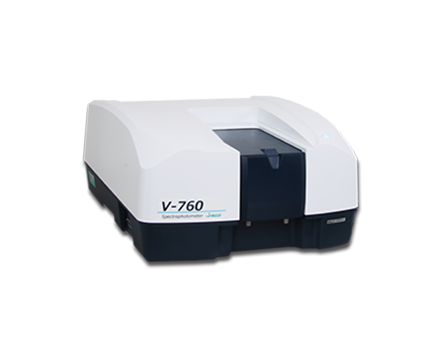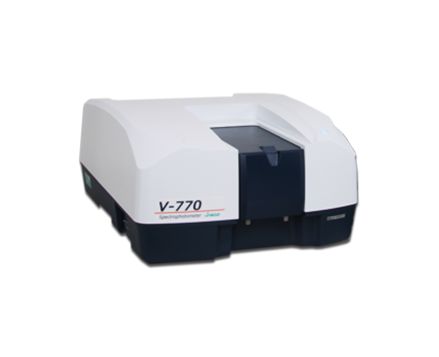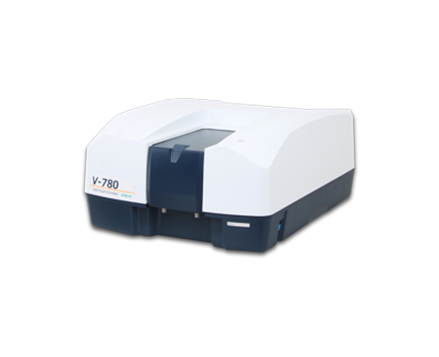Eliminating Fluorescence Artifacts from the Diffuse Reflectance Measurement of Sodium Salicylate
August 15, 2022
Introduction

A fluorescent powder may be evaluated by its fluorescence spectrum, excitation spectrum, external/internal quantum efficiency and luminescent color. In addition, a diffuse reflectance spectrum may be required for evaluating its absorption spectrum. However, when making diffuse reflectance measurement of fluorescent materials using a UV-visible spectrophotometer with integrating sphere, since the scattered light and sample fluorescence cannot be separated, the sum of these will combine to provide the result of a reflectance measurement. Therefore, to obtain the true reflectance, this fluorescence artifact should be corrected for.
In this application, the procedure to eliminate a fluorescence artifact will be demonstrated using sodium salicylate as the sample (a typical powdered sample that exhibits fluorescence).
Experimental
Instrument
- V-650 UV-visible spectrophotometer
- ISV-722 60 mm UV-visible integrating sphere
- Powder sample holder
- Reference white plate
- L42 band pass filter
Measurement
1). In order to reduce the artifact caused by fluorescence, an L42 band pass filter was placed in front of the detector so that the fluorescence is rejected and the scattered light from the irradiation light is transmitted.
2) In single beam mode, spectra were measured of a standard white plate and sample without using the L42 filter.
3). The same single beam spectra were measured while using the L42 filter.
The transmittance of the L42 filter is calculated as the ratio of two spectra of the standard white plate measured with and without filter Fig. 1 (a). The single beam spectra of sodium salicylate measured with and without filter are shown in Fig. 1 (b). The L42 band pass filter has 50% transmission at 420 nm, and cuts wavelengths shorter than 420 nm, it is evident that the transmittance in the range shorter than 420 nm was significantly reduced when measured with the filter. Also, the spectrum of sodium salicylate measured without the filter indicates that most of the signal intensity at wavelengths shorter than 370 nm was from fluorescence.

The fluorescence spectra of sodium salicylate measured with and without L42 filter are shown in Fig. 2. The peak measured with filter (light blue) was observed as fluorescence and the peak without filter (pink), as total fluorescence, the ratio of the peak area was calculated, this is used as a factor for obtaining the total fluorescence from the fluorescence. The calculated ratio was 1.0556, by multiplying the single beam spectrum of sodium salicylate measured with filter by this factor (light blue; Fig. 1, b), the total fluorescence was obtained. Then, the true diffuse reflectance component was obtained by the subtracting the total fluorescence from the single beam spectrum of sodium salicylate measured without filter (pink; Fig. 1, b).

The true diffuse reflectance component of sodium salicylate is shown in Fig. 3 together with the diffusive reflectance component of the standard white plate obtained using the same procedure. Since the component of the standard white plate can be considered as the 100% line, the diffuse reflectance spectrum of sodium salicylate (Fig. 4) was obtained from the ratio of the two spectra shown in Fig. 3.
NOTE: The cut-off wavelength of L42 filter is 410 nm. Therefore, in this example the correction procedure can only be applied to a wavelength range shorter than 410 nm.

Featured Products:
-

A high resolution UV-Visible double-beam, double-monochromator spectrophotometer with exceptional stray light and absorbance linearity
V-760 UV-Visible Spectrophotometer
-

Wide range UV-Visible/Near Infrared Spectrophotometer with PbS detector for wavelengths up to 3200nm
V-770 UV-Visible/NIR Spectrophotometer
-

A high sensitivity UV-Visible/NIR Spectrophotometer with InGaAs detector for wavelengths up to1600nm
V-780 UV-Visible/NIR Spectrophotometer

Eliminating Fluorescence Artifacts from the Diffuse Reflectance Measurement of Sodium Salicylate
Introduction

A fluorescent powder may be evaluated by its fluorescence spectrum, excitation spectrum, external/internal quantum efficiency and luminescent color. In addition, a diffuse reflectance spectrum may be required for evaluating its absorption spectrum. However, when making diffuse reflectance measurement of fluorescent materials using a UV-visible spectrophotometer with integrating sphere, since the scattered light and sample fluorescence cannot be separated, the sum of these will combine to provide the result of a reflectance measurement. Therefore, to obtain the true reflectance, this fluorescence artifact should be corrected for.
In this application, the procedure to eliminate a fluorescence artifact will be demonstrated using sodium salicylate as the sample (a typical powdered sample that exhibits fluorescence).
Experimental
Instrument
- V-650 UV-visible spectrophotometer
- ISV-722 60 mm UV-visible integrating sphere
- Powder sample holder
- Reference white plate
- L42 band pass filter
Measurement
1). In order to reduce the artifact caused by fluorescence, an L42 band pass filter was placed in front of the detector so that the fluorescence is rejected and the scattered light from the irradiation light is transmitted.
2) In single beam mode, spectra were measured of a standard white plate and sample without using the L42 filter.
3). The same single beam spectra were measured while using the L42 filter.
The transmittance of the L42 filter is calculated as the ratio of two spectra of the standard white plate measured with and without filter Fig. 1 (a). The single beam spectra of sodium salicylate measured with and without filter are shown in Fig. 1 (b). The L42 band pass filter has 50% transmission at 420 nm, and cuts wavelengths shorter than 420 nm, it is evident that the transmittance in the range shorter than 420 nm was significantly reduced when measured with the filter. Also, the spectrum of sodium salicylate measured without the filter indicates that most of the signal intensity at wavelengths shorter than 370 nm was from fluorescence.

The fluorescence spectra of sodium salicylate measured with and without L42 filter are shown in Fig. 2. The peak measured with filter (light blue) was observed as fluorescence and the peak without filter (pink), as total fluorescence, the ratio of the peak area was calculated, this is used as a factor for obtaining the total fluorescence from the fluorescence. The calculated ratio was 1.0556, by multiplying the single beam spectrum of sodium salicylate measured with filter by this factor (light blue; Fig. 1, b), the total fluorescence was obtained. Then, the true diffuse reflectance component was obtained by the subtracting the total fluorescence from the single beam spectrum of sodium salicylate measured without filter (pink; Fig. 1, b).

The true diffuse reflectance component of sodium salicylate is shown in Fig. 3 together with the diffusive reflectance component of the standard white plate obtained using the same procedure. Since the component of the standard white plate can be considered as the 100% line, the diffuse reflectance spectrum of sodium salicylate (Fig. 4) was obtained from the ratio of the two spectra shown in Fig. 3.
NOTE: The cut-off wavelength of L42 filter is 410 nm. Therefore, in this example the correction procedure can only be applied to a wavelength range shorter than 410 nm.


 Download This Application
Download This Application